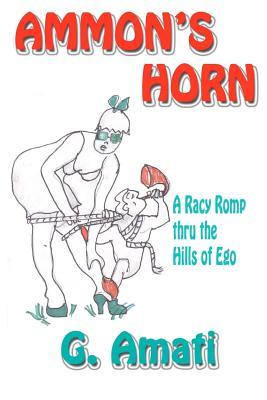Title: Ammon’s Horn: A Racy Romp thru the Hills of Ego
Author: G. Amati
Publisher: Savant Books & Publications LLC
ISBN: 978-0984117581
Pages: 370, Paperback
Genre: Humor/Fiction
Reviewed by: Jason Lulos, Pacific Book Review
Book Review
Audacious in scope, author G. Amati Ammon’s Horn: A Racy Romp thru the Hills of Ego emerges as an intricate, multifarious and humorous tale of a futuristic scenario involving grand collusion within the technological-economic complex. A satire of the hope of global capitalism, Amati’s grand scheme centers around an improbable real estate deal; although the scheme becomes less improbable and much more complicated with the intervention of advanced quantum physics, bottling psychic essence and divine intervention. The novel bounces from character to character, from continent to continent and, eventually, from dimension to dimension, showing how globalization’s interconnections between people and companies reveal real analogues to quantum events such as entanglement and chaos theory, all ending with a convergent flourish.Imagine you are a cross country motorcyclist who wakes one day to find his consciousness merged with the psyches of three others, most notably a physicist named Polichuk, winner of multiple Nobel Prizes. Then imagine that this appropriation of your mind is directly connected with a conspiracy to colonize the fifth dimension in an audacious real estate coup. And this is all in the wake of the privatization of the United States and it is at the height of global capitalism. The motorcyclist is Benni Pistone and if there is a hero in this story, it could be him. However, the novel is, holding fast to its consistency of analogues to science, all about interactions and reactions. So, the characters come across more like sentient chemicals in some experiment in a mad scientist’s laboratory. The hope against hopelessness is that these sentient, and sometimes slapstick, chemicals learn what their interactions are capable of.
However, in this mockumentary of a future dystopia, the chemical characters are not manipulated by some outside force or maniacal scientist. The hapless and oftentimes laughable Apollo is just as much a pawn as the mortals. Even Aphrodite, his more logical God-counterpart, is no more than a contributing chemical. That’s what makes the novel so funny. Everyone runs around crashing into each other, across dimensions, time, and planes of existence. It comes down to how “Y can influence X” into doing Z. If there is a mad scientist in this scenario, it is the reader; the one who sits back and watches the chaos of the nitwits unfold.
One of the things most striking in this novel is the mental acuity of the scientific and technological aspects, inasmuch as they are foreseen 70 years into the future. Also cogent yet complicated is the thematic thread that runs throughout these scientific ideas. The novel succeeds in thematically linking subjects such as existential psychology, the unified theory of physics, psyche-transference, mythology and capitalism. It does so logically, but also Absurdly; so, it is no surprise that its ridiculous plausibility is intentionally comical.
Characters in the novel include Gods, scientists, con artists and wanderers. G. Amati’s characters involuntarily consult with Gods and some voluntarily consult with computer programs designed to provide sound advice; both of these serve as the influential but not deterministic role that the witches play in Macbeth. Ammon’s Horn is a comedic supposition on the spheres of influence and how people sift or not through that data in order to make authentic choices. This idea of how we are influenced is one of the themes which creeps up here and there amidst the broader themes like the pros and cons of technology, collusive politics, extreme capitalism and the traces of Humanism. While each character, at times playing different roles, faces some new obstacle, it becomes his or her choices (in keeping with the responsibility and self-making of existentialism) that create his/her own essence. Visiting each character are those swirling winds of influence of those broad themes which commute back and forth from divine to corporate to individual. The end result, or sum over histories, is a product of decisions made from these pools of probabilities and choices. The lingering question for me was how much choice was determined by physics, the divine, our own technology/economics or our own existential selves.


